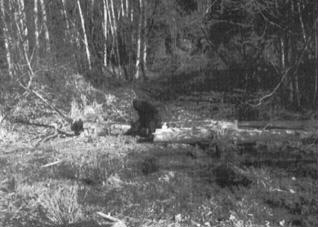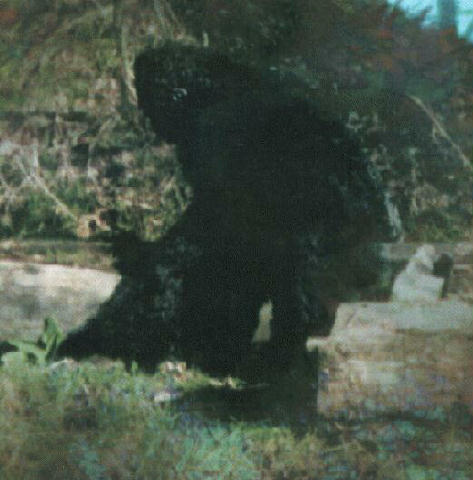Bigfoot Encounters
New $10k Bigfoot Photo Investigation 1993
By Mark Chorvinsky
It is not common that an important new Bigfoot photograph, such as that on the facing page, comes to our attention. This photo deserves to be the object of study, for it is part of a complex case that has been playing out for decades. An investigation of the photograph means a trip back to the birth of Bigfoot in 1958 and a brief glance into the most holy of Bigfoot artifacts -- the Patterson Bigfoot film.
September 21, 1993.
Ray Wallace wrote the following about the photograph:
"Here is a picture of a female Big Foot... I bought it, the negative, from a photographer who was up near Mt. St. Helens in March taking pictures when he saw this giant sized female sitting on a log asleep as she was so heavy with a baby inside of her that she could not move very fast, he said she would have been easy to capture while sleeping on this log on an old abandoned loading site where they used to load out logs several years ago. He said she was just sitting out in the warm sun and went to sleep."

I have spoken to Ray Wallace and he will not divulge the name of the individual from who he claims to have purchased the photograph. Wallace has said in conversation with the author that he purchased all rights to the photograph for $10,000 (1). In a letter dated "January" (postmarked January 13, 1994), however, Wallace writes: "I just sent Ray Crowe... a picture of a pregnant female sitting on a log asleep on a warm sunny day that I took in 1990 west of
I contacted Ray Crowe, director for the Western Bigfoot Society based in
The photograph shows a Bigfoot-type "creature." The creature does not appear to have been composited into the scene. Telltale signs of optical or computer compositing are not apparent. Therefore it is most probably not a model, painting, or composite. This would mean that the photograph is of a full-size "creature" photographed in its surroundings. The question then becomes: is the "creature" in the photograph a "real Bigfoot" or a "guy-in-a-suit?" In a dark shot like this one there is little detail to make it possible to determine from the photograph alone if the entity depicted is a creature or a person in a suit. Therefore, the context becomes particularly important. We do not know a great deal about the photograph and have little expectation of learning much more. From what can be seen in the photograph and from what we know of its source, however, it would be prudent to focus our lens on Ray Wallace.
There at the Birth
In August 1958, the Wallace Construction Company -- owned and operated by Ray Wallace -- subcontracted to clear roads near the borders of Humboldt and
A bulldozer operator named Gerald (Jerry) Crew claimed to have found a series of footprints that led to his tractor, circled it, and walked away from the machine. The 16-inch-long prints were of naked humanoid feet with a 46- to 60-inch stride -- almost twice that of most people. Later print discoveries and other odd events led to the story being carried across the country via the wire services and Bigfoot was "born" and named.(2, 3)
The connection between the case that gave birth to Bigfoot and Ray Wallace is largely ignored in Bigfoot circles. In his book 'Abominable Snowmen: Legend Come to Life' and his article on the case in 'True Magazine, Ivan T. Sanderson mentions Wallace in connection with the original Bluff Creek case, portraying him as the skeptical, pragmatic contractor. John Green, in 'Sasquatch: the Apes Among Us', devotes hundreds of pages to obscure Bigfoot-like accounts, but manages to ignore Ray Wallace completely!
In Dr. Grover Krantz's book 'Big Footprints', Wallace is not even mentioned. Since 1958, however, Wallace has claimed to have seen Bigfoot -- and many members of his clan -- numerous times, and has allegedly filmed the creatures repeatedly. He also has a collection of footprint casts. Why would Wallace, the owner of so much Bigfoot footage and so many footprint casts -- not to mention being an eyewitness to many alleged Bigfoot encounters -- have been excluded from, or downplayed in, most of the official Bigfoot histories?
Ray Wallace: Bigfoot's First Cinematographer?
John Napier, in 'Bigfoot: the Yeti and Sasquatch in Myth and Reality', devotes one paragraph to Wallace, noting that it is claimed that Bigfoot has been filmed three times, initially by Ray Wallace, who says that he took his film of the creature in 1957 (prior to the first "Bigfoot" case in 1958).(4) Napier points out that Wallace's claim to have filmed Bigfoot so early in the game was only announced to the press in late November 1970.
These films -- if taken when claimed -- predated the famous Patterson film by ten years. If some still exist, they are important visual documents in the cultural history of Bigfoot.
Ray Wallace says that he has shot thousands of feet of Bigfoot film footage. Figures have varied from 6,000 to 15,000 feet of 16mm film. This amounts to hours of footage, which includes Bigfoot throwing stones, eating frogs, and so forth. Wallace maintains that his films, photos and tapes are authentic.
The Patterson Connection
In
The superficial resemblance of the Bigfoot in the photograph to that in the Patterson film should be of some interest. Both the Patterson Bigfoot and the Bigfoot in the Wallace photograph are said to be females, both are rather bulky (as opposed to the "creatures" in most known hoax footage), and both have a head that is somewhat pointed.
A Role Worthy of Attention
Ray Wallace, now 75, prefers to stay behind-the-scenes these days. He is not out to make money on his photographs or films, or to get publicity. A successful and generous individual, he has given away hundreds of Bigfoot photographs and posters to students internationally and has owned a free petting zoo full of rare animals, for the benefit of children. Ray's association with Bigfoot is a big part of his life -- enough so that Bigfoot put in an appearance at his fiftieth wedding
Bigfoot expert Mark Opsasnick, author of 'The Bigfoot Digest', opines that, "If one does objective research into the origin of Bigfoot, it is obvious that the role Wallace played in the creation and development of Bigfoot cannot be ignored. He was there when the term 'Bigfoot' originated in 1958 as an important player in the case surrounding Jerry Crew, and Roger Patterson consulted with him repeatedly. This is a fact ignored by the contemporary Bigfoot investigators." Opsasnick concludes that, "It is quite conceivable that if there had been no Ray Wallace, there would be no Bigfoot as we know it today.”
We look forward to seeing other Bigfoot photographs and films taken by Ray Wallace, a man who has had a pivotal behind-the scenes role in the unwritten history of
Notes
1. Ray Wallace, conversation with the author, 19 October 1993.
2. The term "Bigfoot" was coined in late August 1958, when the Humboldt
Times in
Yet accept it they did and in the last 35 years this "balmy" notion has become a star of the cryptozoological menagerie.
3. I would be remiss not to note that, according to 'The Humboldt Times', the Humboldt sheriff's office investigated the series of sightings and other strange occurrences surrounding Wallace's road crew, and allegedly made accusations that Roy Wallace, one of Ray's two brothers, had "perpetrated a hoax on his own construction job." Roy Wallace objected strongly to this accusation, arguing that he would hardly want to sabotage his own job. (The Humboldt Times, 14 October
1958).
It is also a well known fact that Ray Wallace was out of the State of California when the first tracks were found and reported; upon his return, he was furious that someone was fooling around with the heavy equipment and disturbing his operations to the extent that was happening. (Sanderson)
4. John Napier, 'Bigfoot: the Yeti and Sasquatch in Myth and Reality' (New York: E.P. Dutton, 1973), pp. 83-84.
5. Roger Patterson describes meeting with Ray Wallace in Patterson's 'Do Abominable Snowmen of America Really Exist!' (
Franklin Press, Inc., 1966), pp. 63-64.
6. For more information about Ray Wallace, see the author's November 1993 'Fate' column.
© Mark Chorvinsky, Strange Magazine, No. 13
Chorvinsky, Mark (1954 – 2005) former editor of Strange Magazine unashamedly lied about an interview he claimed he had with
Back to Bigfoot Encounters Main page
Back to Newspaper & Magazine Articles
Back to Bigfoot Encounters "What's New" page
Portions of this website are reprinted and sometimes edited to fit the standards of this website
under the Fair Use Doctrine of International Copyright Law
as educational material without benefit of financial gain.
http://www4.law.cornell.edu/uscode/17/107.html
This proviso is applicable throughout the entire Bigfoot Encounters Website.